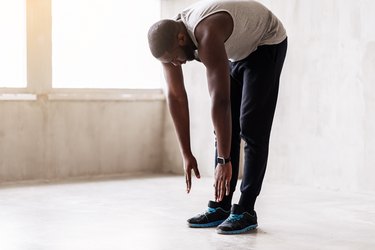
Some exercises are named after the animals that inspired the move. Case in point: the inchworm, which mimics the up-and-down motion of a worm. But don't let the silly moniker fool you — the inchworm can help you get stronger and more flexible inch by inch.
Inchworm Exercise Benefits
Video of the Day
The inchworm is often overlooked as one of the best compound exercises, says Matt Cheng, CSCS, co-creator of Beyond the Movements. Compound exercises (like inchworms, squats and deadlifts) work several muscle groups at the same time and "maximize your fitness results when it comes to effectiveness, efficiency and functionality," Cheng says.
When done properly, the inchworm is an effective total-body movement that will strengthen you from the ground up, Cheng says. The low-impact exercise increases hamstring flexibility (reaching your hands to your toes), improves hip mobility (hinging at your hips) and builds shoulder stability and core strength (supporting your body weight in a plank).
Because it simultaneously stretches and strengthens multiple muscle groups and gets the blood pumping, the inchworm can be a great addition to any sweat session including a dynamic warm-up, mobility routine or core strength workout.
Inchworm Exercise Description
- Start by standing at the back of your mat, then bend your knees slightly and reach your hands to the ground.
- Brace your core as you walk your hands out in front of you into a high plank with your hands beneath your shoulders and a neutral spine.
- Keeping your core tight, walk your hands back to meet your feet and return to standing.
Common Inchworm Mistakes to Avoid
While the inchworm boasts a boatload of benefits, poor form can make the move less effective. Here are the most common mistakes to avoid when performing inchworms.
- Swaying the hips from side to side when you walk into plank. This will lead to less core activation, Cheng says. Concentrate on keeping your core tight and your hips steady.
- Sagging the hips during the plank. This puts more pressure on the lower back, Cheng says. Focus on activating your abs by drawing your bellybutton toward your spine.
- Finishing with hands too far forward in the plank. This puts more stress on your shoulders, Cheng says. Aim to keep your shoulders aligned with your wrists while in plank.
- Not putting tension in the fingers and hands during the walkout. This could lead to pain around the wrists, Cheng says. Remember to actively push against the floor to engage the muscles in your hands and protect your wrists.
Inchworm Modifications
If the inchworm feels to challenging, you can modify the move to fit your fitness level and needs.
Break the movement into parts. Instead of walking your hands back to your feet from plank, you walk your feet back to your hands, taking some load off the shoulders.
Skip the standing entirely. Once in plank, alternate between walking your feet toward and away from your hands.
Inchworm Progressions
Up for a challenge? The best part about the inchworm is that you can add just about any move to ramp up the difficulty factor, Cheng says. Here are a few ideas:
- Add a push-up. After you walk your hands out to plank, perform a push-up before walking your hands back to your feet.
- Incorporate a plank jack. Once you've walked your hands out to plank, jump your legs out and in, then walk your hands back to your feet.
- Sneak in a squat. Do a deep squat between each inchworm repetition.